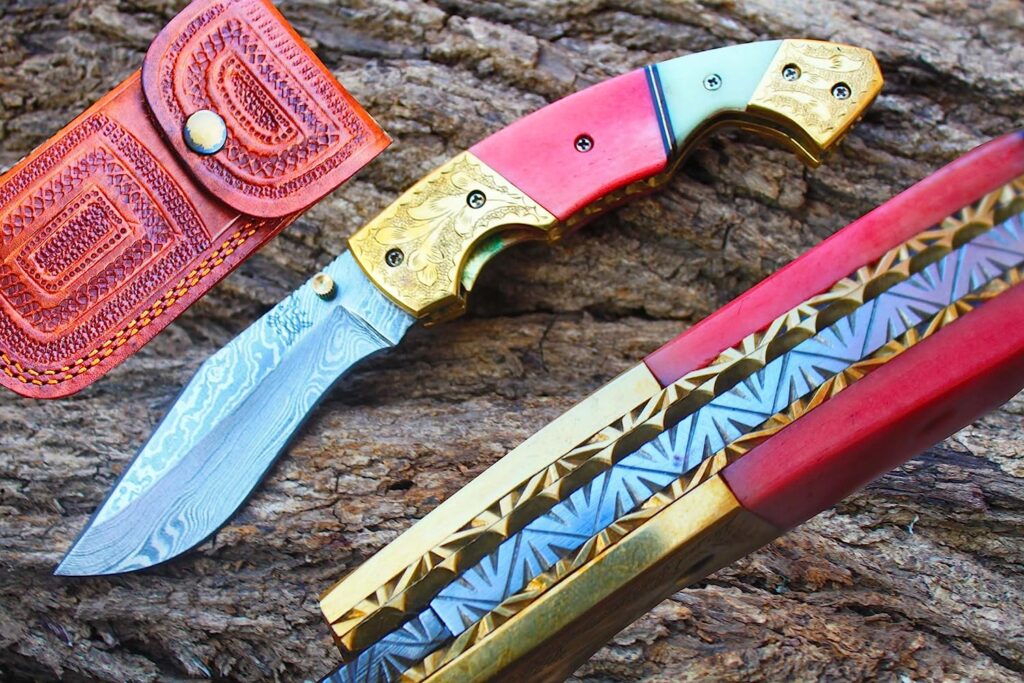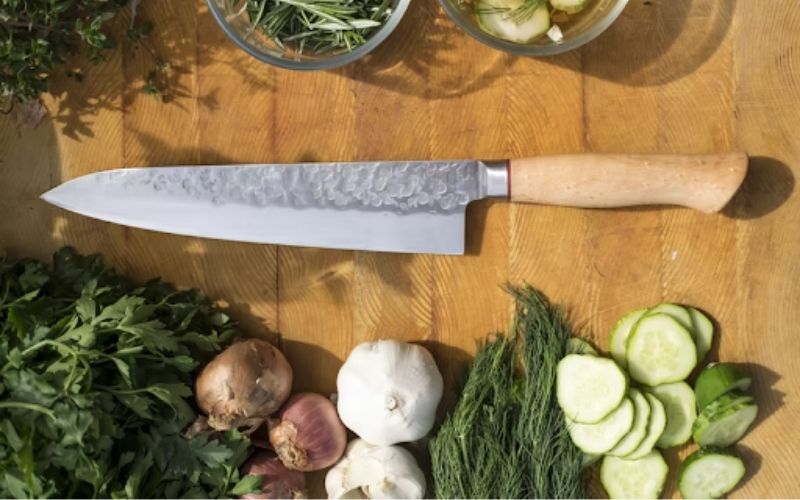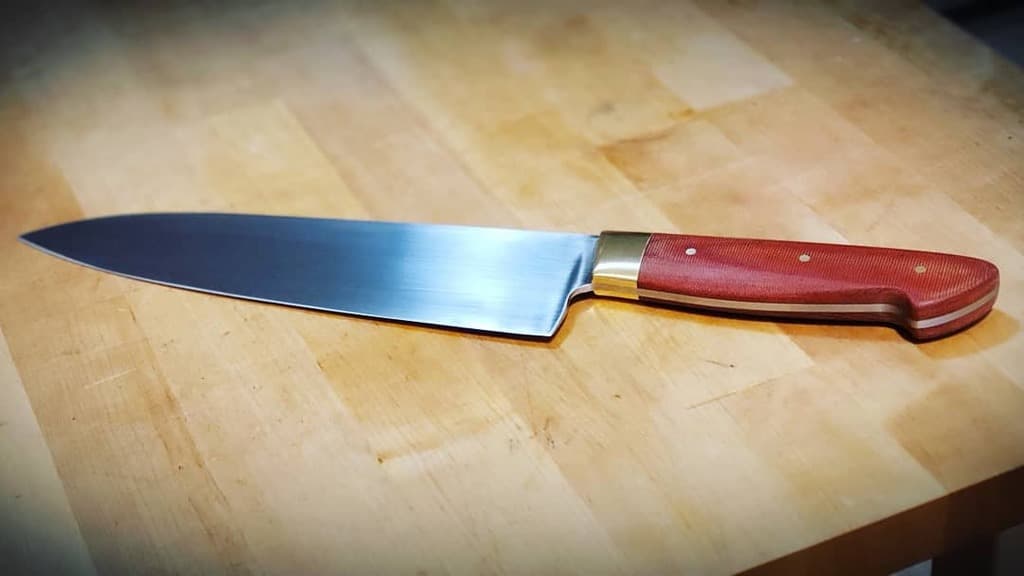Chefs and home cooks must know how knives work. The knife bolster affects balance, stability, and performance. This guide will cover knife bolsters’ function, types, benefits, and more. This article will teach you about knife bolsters, whether you’re a professional chef or a newbie cook.
What is a Knife Bolster?
Knife bolsters join the blade and handle in cutlery. Its major purpose is to smooth the blade-to-handle transition, giving chefs balance and composure. The bolster juxtaposes the blade and gives the handle heaviness, improving precision and reducing fatigue.
A knife bolster prevents the user’s hand from accidentally touching the blade. It also protects fingertips, ensuring a firm grip and reducing kitchen accidents.
Knife bolsters are mostly seen in hand-forged knives, when a single piece of metal is heated and formed, but some high-quality stamped blades have them too.
The Anatomy of a Knife Bolster

A knife’s bolster connects the blade and handle. It’s versatile:
Position: The bolster is at the handle-blade junction. It produces a thick, generally metallic collar around the tang (the blade’s handle extension).
Strength and Balance: The bolster strengthens and balances the knife. It improves knife handling by adding weight and stability.
Finger Guard: The bolster prevents your hand from sliding onto the blade. It protects your fingers from the cutting edge.
Blade Support: The bolster strengthens and prevents the blade from fracturing or detaching from the handle.
Smooth Transition: The bolster smooths the blade-to-handle transition, ensuring a pleasant grip and precision cutting.
Material: Bolsters are usually constructed of stainless steel or brass. They can be forged into the blade or added during manufacturing.
Bolster Shape: Knife design and purpose determine bolster shape. It might cover the entire blade or merely part of the tang.
Types of Knife Bolsters

Knife bolsters have different shapes and benefits. Common knife bolsters are:
Full Bolster: A complete bolster spans the knife’s handle. It’s great for heavy-duty operations for expert chefs who need precision and balance.
Half Bolster: A half bolster covers only part of the knife’s handle. Its reduced weight and pinch grip make it perfect for complicated tasks that need agility and manoeuvrability.
Slanted Bolster: Slanted bolsters taper towards the blade. This ergonomic design reduces hand strain and fatigue. Japanese chefs prefer slanted bolsters for efficiency and comfort.
No Bolster: Some modern knives have a seamless blade-to-handle transition without a bolster. Cooks who prefer mobility and precision over weight will like these knives.
Benefits of Knife Bolsters

Knife bolsters improve performance and functionality. Key benefits:
Balance and Stability: The bolster’s weight distribution balances the knife, improving cutting control. This balance increases cut accuracy and precision, producing professional-quality cuisine.
Safety: The bolster’s finger guard secures the grip and prevents inadvertent blade contact. This device prevents kitchen injuries when handling sharp knives.
Durability: Knife bolsters, especially forged ones, strengthen the blade. Heavy use reduces the likelihood of breakage or detachment at the bolster-blade connection.
Comfort: A well-designed bolster makes long-term knife use more comfortable. The user’s hand rests naturally on the bolster, eliminating wrist fatigue.
Precision Cutting: The bolster’s weight and balance optimise cutting. The bolster improves control and manoeuvrability for precise cuts, making it crucial for chefs and gourmet fans.
How to Maintain a Knife Bolster

Knife bolster care prolongs its life and functionality. Maintaining your knife bolster:
soap and water. Remove food residue with a soft sponge or cloth. Avoid aggressive abrasives and scrubbers that can scrape the bolster.
Drying: After cleaning, dry the knife, especially the bolster, to avoid rust. Before storing, wipe the bolster dry.
Avoid Immersion: Don’t soak the knife. Moisture damages the bolster and handle.
Proper Storage: Proper knife storage protects the blade and bolster from wear and injury. Avoid scratching the bolster with sharp things.
Regular Sharpening: Maintain blade sharpness for best performance. Sharpen your knife regularly, taking care not to harm the bolster.
Professional Maintenance: If your knife bolster has considerable damage, see a respected knife sharpener or cutlery expert. They may inspect and fix your knife.
Common Questions
Knife bolsters serve what?
Knife bolsters are multipurpose. It balances the blade for stability and control. It also protects the user’s hand from the blade’s sharp edge as a finger guard.
Are all knives bolstered?
Forged knives with one-piece blades and bolsters have bolsters. Some high-quality stamped knives have them. Modern knives without bolsters are lightweight and nimble.
Knife bolsters: customizable or replaceable?
Knife bolsters are usually permanent parts of the knife’s structure. Some speciality knives have changeable bolsters. Consult your knife’s manufacturer or a knife expert for specifics.
Are knife bolsters effective?
Knife bolsters impact performance. They improve accuracy and precision by balancing, stabilising, and controlling the knife. Well-designed bolsters improve cutting.
Conclusion
Cooking enthusiasts must understand knife bolsters. The bolster’s balance, stability, and control are crucial. Knife bolsters improve cutting and cooking safety for chefs and amateur cooks.
This guide covered knife bolster anatomy, kinds, and benefits. Knife bolsters improve balance, stability, and precision. We also have knife bolster maintenance advice.
Understanding a knife bolster’s purpose in cooking might help you choose kitchen knives. Choose a knife bolster based on your needs, tastes, and daily duties.
Maintaining your knife bolster is essential to its longevity and functionality. Your knife bolster will last for years with frequent cleaning, drying, and sharpening.
